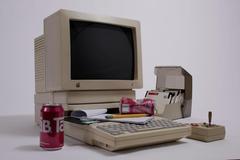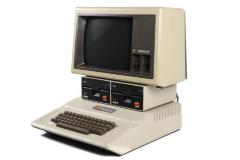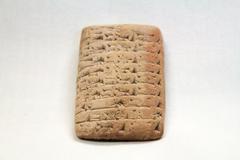Comments and Tags
Be the first to comment on this item!
Computers and Electronic Games ➔ Digital Music Player, Apple iPod
Identifier:
2009.23.1Description:
This is a third generation iPod. It has a white face and metallic back. The 1.5 inch screen in monochromatic. The face has a touch-sensitive click wheel and 4 touch-sensitive buttons. The buttons are (from left to right) back, menu, play/pause, forward. The top of the iPod has a headphone jack, a fire wire port and a hold switch. The bottom has a proprietary iPod port. The separate earbuds consist of a white cord which splits into two strands, at the end of each strand is a small speaker that the user can place in each ear to listen to the music on the device.
The iPod is perhaps the most iconic device of the early twenty-first century. With hundreds of millions sold worldwide, the pocket-sized music players with their trademark white cord and earbuds have become a symbol of musical, technological, marketing, and cultural change. Musically, the iPod and its companion software, iTunes, have been the catalyst for a major change in the way people acquire and listen to music. Given the ability to legally and cheaply download music from the internet, people responded by moving away from the traditional model of buying whole albums and instead created the idea of a "playlist" made up of a variety of songs selected by the user to compliment a particular mood, activity, or event. The iPod was also a technological marvel, notable for its small size, large capacity, and ability to sync easily with most modern computers. Apple's marketing of the device is largely responsible for the cultural shift that made the iPod the quintessential gadget that it is. By combining advertising, design, and functionality the company was able to create a phenomenon that swept the world. Critics denigrate Apple and the iPod for being overpriced, using proprietary software, and encrypting music sold by their service with a form of Digital Rights Management (before 2009) which prevented it from being played on any other devices. Despite these impediments the iPod has been incredibly successful by almost any measure.
The back of the device has marks etched into the metal. There is the Apple logo, and the words "iPod 15GB" as well as the Serial # (JQ420MKUQQF) as well as some other copyright, and FCC information.
Date:
2003Materials:
Metal, PlasticDimensions:
4" h 2.50 | .01" w .05 | .01" d; 46" hCurrent Location Status:
In StorageCollection Tier:
Tier 2Source:
Gift Of Sara And Alex ForistLinks:
http://www.apple.com/ipod/https://www.britannica.com/technology/iPod
Exhibits/Programs:
Artifact GR (2012 – 2013)Artifact GR was a project which invited members of the community into the archives of the Grand Rapids Public Museum, and asked them to write about their experiences. The resulting submissions were cataloged in an interactive website (www.artifactgr.org) and in a published book (http://www.blurb.com/b/4400444-the-artifact-projectsoftcover).
L is for Lyceum - Incredible Inventions (December 21 2018 – December 1 2019)
Can you imagine that the only way to talk to your friend is by letter because the telephone has not been invented? What about telling time not on your wristwatch, but by relying on the position of the sun? Or that there are no computers to type on or emails to send, just a quill and an inkwell?
From technological to medical devices, these artifacts selected by the Grand Rapids Public Museum Middle School students are common everyday artifacts from the GRPM’s Collection that are often overlooked as important inventions. They can inspire us to think about the incredible work done by inventors to solve problems and design devices that have not only made our lives easier - but better!
In the ancient world, the lyceum was where the greatest Greek philosophers taught. The concept of the lyceum was revived by American intellectuals in the 19th century who believed that public education was an important part of our democracy. Founded in 1854, the Grand Rapids Public Museum was originally named the Grand Rapids Lyceum of Natural History. In 2015 the Grand Rapids Public Museum School was founded with many community partners. The Museum School has developed its own version of the lyceum - an innovative after-school program that pairs local experts with middle school learners to exercise their minds and bodies by exploring an eclectic range of topics.
This changing exhibit was created by a class of lyceum students who designed the exhibit from start to finish, choosing the topic, selecting the artifacts and writing the text.
L is for Lyceum is one section of the interactive exhibit Collecting A to Z. This exhibit includes thousands of treasures from the GRPM’s Collections featured throughout the Museum.
Related Entities:
Apple Inc. (creator)Alternate names: Apple Computer Inc. Alex Forist (donor)
Curator at the Grand Rapids Public Museum.



